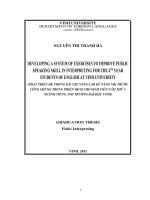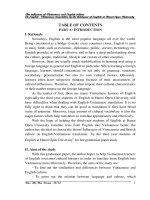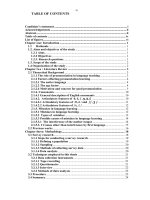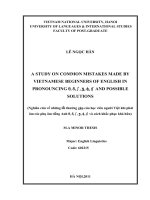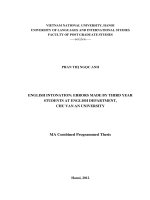A study on pronunciation errors made by fourth year students of english at vinh university and suggested solutions
Bạn đang xem bản rút gọn của tài liệu. Xem và tải ngay bản đầy đủ của tài liệu tại đây (351.53 KB, 74 trang )
VINH UNIVERSITY
FOREIGN LANGUAGES DEPARTMENT
**********
Ngun thÞ hång anh
A STUDY ON PRONUNCIATION ERRORS MADE BY
FOURTH YEAR STUDENTS OF ENGLISH AT VINH
UNIVERSITY AND SUGGESTED SOLUTIONS
(NGHIÊN CỨU TÌM LỖI PHÁT ÂM TIẾNG ANH CỦA SINH VIÊN
NĂM THỨ TƯ KHOA NGOẠI NGỮ- ĐẠI HỌC VINH
VÀ GỢI Ý MỘT SỐ BIỆN PHÁP KHẮC PHỤC)
GRADUATION THESIS
Field: Linguistics
Vinh 2010
1
VINH UNIVERSITY
FOREIGN LANGUAGES DEPARTMENT
**********
A STUDY ON PRONUNCIATION ERRORS MADE BY
FOURTH YEAR STUDENTS OF ENGLISH AT VINH
UNIVERSITY AND SUGGESTED SOLUTIONS
(NGHIÊN CỨU TÌM LỖI PHÁT ÂM TIẾNG ANH CỦA SINH VIÊN
NĂM THỨ TƯ KHOA NGOẠI NGỮ- ĐẠI HỌC VINH
VÀ GỢI Ý MỘT SỐ BIỆN PHÁP KHẮC PHỤC)
GRADUATION THESIS
Field: Linguistics
Student:
NGUYỄN THỊ HỒNG ANH, 47B
Supervisor: PHAN THỊ HƯƠNG, M.A.
Vinh 2010
2
ACKNOWLEDGEMENT
To complete the research, I have been lucky to receive invaluable
contributions from many people. First of all, I should like to express my
sincere gratitude to my supervisor, Ms. Phan Thi Huong, M.A for her
indispensable supports, suggestions, advice and detailed comments, without
which the research would not have been completed.
In addition, I would also like to extend my deepest thanks to teachers of
phonetics – Ms. Mindy Schott, Mr. Tran Ba Tien, MA and Mr. Pham Anh
Tuan, MA for their materials of phonetics , my close friends - Oanh and Sơn
for their reading my first draft as well as their invaluable suggestions, and
comments and to all of my classmates for their various kinds of help and
encouragement.
My warmest thanks are due to my loving parents and my siblings for
their absolute unconditional love, support and forbearance.
Finally, I am all too aware that despite all the advice and assistance, I
feel that the research is far from perfect; it is, hence, my sole responsibility
for any inadequacies and shortcomings that thesis may be considered to
have.
Vinh, May, 5th , 2010
Nguyen Thi Hong Anh
3
4
ABSTRACT
Nowadays, when English is used in larger and larger scale as an
international language, it is an essential duty of education that users of
English should communicate successfully with the target language. It is a
common knowledge that phonetics is a subject which helps students of
English to pronounce well in learning and communicating in English.
However, many teachers of English have complained and many learners have
self- criticized about their pronunciation. So have students of English at Vinh
University. Indeed, in spite of being taught basic phonetics right in the first
year of learning English, many of fourth year students of English at Vinh
University are weak at pronouncing in English. This has much influence on
their learning other subjects such as: listening, speaking, reading,
interpreting etc as well as creates many limitations in their talking with
native- speakers of English. In this research, the author studied typical
pronunciation errors made by fourth year students of English at Vinh
University, then suggested the students of English in general and fourth year
students of English in particular some ways to improve their pronunciation as
much as possible. Questionnaire data was collected from 61 students from
two classes 47A and 47B, then among them, 22 students were asked to record
their pronunciation at their own home. The findings point out that fourth year
students tend to make pronunciation errors with vowels and consonants. Yet,
they have not had any real effective method to improve their pronunciation
errors yet. Therefore, the author, as a fourth year student, somehow, hopes
that this paper will partly help fourth year students to be better at
pronouncing in English.
5
ABBREVIATIONS
FLD:
Foreign Languages Department
VU:
Vinh University
CD:
Compact disc
EFL:
English as a Foreign Language
RP:
Received English
E.g.:
exampli gratia
Etc:
et cetera
L1:
Language one
SL:
Second language
FL:
Foreign language
PR.:
Public Relation
6
TABLE OF CONTENT
Page
ACKNOWLEDGEMENT...............................................................................i
ABSTRACT.....................................................................................................ii
ABBREVIATIONS........................................................................................iii
TABLE OF CONTENT.................................................................................iv
.............................................................................................................................
.............................................................................................................................
.............................................................................................................................
.............................................................................................................................
.............................................................................................................................
.............................................................................................................................
.............................................................................................................................
LISTS OF TABLES AND FIGURES .........................................................vii
.............................................................................................................................
.............................................................................................................................
.............................................................................................................................
PART I: INTRODUCTION..........................................................................1
.............................................................................................................................
.............................................................................................................................
.............................................................................................................................
.............................................................................................................................
1. Justification of the Study.............................................................................1
.......................................................................................................................
.......................................................................................................................
.......................................................................................................................
.......................................................................................................................
.......................................................................................................................
2. Aims and Objectives of the Study...............................................................2
.......................................................................................................................
.......................................................................................................................
.......................................................................................................................
.......................................................................................................................
3. Scope of the Study.......................................................................................2
.......................................................................................................................
.......................................................................................................................
.......................................................................................................................
.......................................................................................................................
.......................................................................................................................
.......................................................................................................................
7
4. Methods of the Study ..................................................................................3
.......................................................................................................................
.......................................................................................................................
.......................................................................................................................
.......................................................................................................................
.......................................................................................................................
.......................................................................................................................
4.1. Subjects of the Study............................................................................3
..............................................................................................................
4.2. Data collection instruments of the Study..............................................3
4.3. Data analysis procedure of the Study...................................................4
5. Format of the Study ....................................................................................4
.......................................................................................................................
.......................................................................................................................
.......................................................................................................................
.......................................................................................................................
.......................................................................................................................
.......................................................................................................................
PART II: DEVELOPMENT.........................................................................5
CHAPTER 1: THEORETICAL BACKGROUND......................................5
1.1. English pronunciation ..........................................................................5
.............................................................................................................................
.............................................................................................................................
.............................................................................................................................
.............................................................................................................................
.............................................................................................................................
1.1.1. Standard English Pronunciation.................................................5
.............................................................................................................................
.............................................................................................................................
.............................................................................................................................
1.1.2. Aspects of pronunciation............................................................6
.............................................................................................................................
.............................................................................................................................
.............................................................................................................................
.............................................................................................................................
1.1.2.1. Articulatory phonetics...................................................6
.............................................................................................................................
.............................................................................................................................
.............................................................................................................................
8
a. The articulators..........................................................6
.............................................................................................................................
.............................................................................................................................
.............................................................................................................................
.............................................................................................................................
b. The process of producing sounds..............................7
.............................................................................................................................
c. The working of the vocal cords.................................7
.............................................................................................................................
.............................................................................................................................
1.1.2.2. English sounds...............................................................8
.............................................................................................................................
.............................................................................................................................
.............................................................................................................................
.............................................................................................................................
.............................................................................................................................
a. Pure vowel Sounds ...................................................8
.............................................................................................................................
.............................................................................................................................
.............................................................................................................................
b. Consonant sounds....................................................11
.............................................................................................................................
.............................................................................................................................
.............................................................................................................................
.............................................................................................................................
1.2. Pronunciation errors: ..........................................................................16
.............................................................................................................................
.............................................................................................................................
.............................................................................................................................
.............................................................................................................................
CHAPTER 2: DATA COLLECTION AND ANALYSIS..........................18
2.1. Subjects...............................................................................................18
.............................................................................................................................
.............................................................................................................................
.............................................................................................................................
.............................................................................................................................
.............................................................................................................................
.............................................................................................................................
.............................................................................................................................
.............................................................................................................................
2.2. Data collection procedure....................................................................18
9
.............................................................................................................................
.............................................................................................................................
.............................................................................................................................
.............................................................................................................................
.............................................................................................................................
2.3. Data analysis procedure......................................................................20
2.4. Findings and Discussion on Pronunciation Errors made
by fourth year students of English.....................................................20
2.4.1. Errors concerned with vowel sounds........................................21
.............................................................................................................................
.............................................................................................................................
2.4.1.1. Description of vowel sounds errors.............................21
.............................................................................................................................
2.4.1.2. Error analysis...............................................................21
.............................................................................................................................
.............................................................................................................................
.............................................................................................................................
.............................................................................................................................
.............................................................................................................................
a. /ɪ/ sounds error analysis ..........................................21
.............................................................................................................................
.............................................................................................................................
b. /æ/ sound error analysis...........................................22
.............................................................................................................................
.............................................................................................................................
.............................................................................................................................
c. /ʊ/ sound error analysis...........................................23
.............................................................................................................................
.............................................................................................................................
2.4.1.3. Typical vowel sounds errors collected from
the recordings..............................................................24
2.4.2. Errors concerned with consonant sounds.................................25
.............................................................................................................................
.............................................................................................................................
2.4.2.1. Description of consonant sounds errors......................25
.............................................................................................................................
2.4.2.2. Error analysis...............................................................25
10
.............................................................................................................................
.............................................................................................................................
.............................................................................................................................
.............................................................................................................................
.............................................................................................................................
a. /∫/ sound error analysis.............................................25
.............................................................................................................................
.............................................................................................................................
.............................................................................................................................
b. /ð / sound error analysis...........................................26
.............................................................................................................................
.............................................................................................................................
c. /dʒ/ sound error analysis..........................................27
.............................................................................................................................
.............................................................................................................................
2.4.2.3. Typical consonant sounds errors collected from
the recordings..............................................................28
CHAPTER 3: FINDINGS AND DISCUSSIONS ......................................29
3.1. Possible Causes...................................................................................29
........................................................................................................................
........................................................................................................................
........................................................................................................................
........................................................................................................................
3.1.1. Making myths about who can teach students pronunciation ...29
3.1.2. Lack of awareness of the importance of pronunciation............30
.............................................................................................................................
3.1.3. Teachers’ neglect of pronunciation..........................................31
.............................................................................................................................
.............................................................................................................................
.............................................................................................................................
3.1.4. Lack of knowledge of pronunciation rules...............................32
.............................................................................................................................
.............................................................................................................................
3.1.5. Mother tongue interference......................................................32
.............................................................................................................................
.............................................................................................................................
.............................................................................................................................
.............................................................................................................................
11
3.2. Suggested solutions.............................................................................33
.............................................................................................................................
.............................................................................................................................
.............................................................................................................................
.............................................................................................................................
.............................................................................................................................
.............................................................................................................................
3.2.1. Suggested solutions for individuals..........................................33
.............................................................................................................................
.............................................................................................................................
.............................................................................................................................
3.2.1.1. Practice pronouncing regularly...................................33
a. Doing pronunciation exercises................................33
b. Recording your own voice and listening again.......34
3.2.1.2. Talking, listening to native speakers and trying to
imitate their voice..........................................................35
3.2.1.3. Creating tips in pronouncing in English......................35
3.2.2. Suggested activities for groups/ pronunciation club.................37
3.2.2.1. Model for a pronunciation club...................................37
3.2.2.2. Pronunciation activities...............................................39
a. Activity 1.................................................................39
b. Activity 2.................................................................41
c. Activity 3.................................................................42
PART III: CONCLUSION...........................................................................46
1. Recapitulation and Implication....................................................................46
2. Suggestions for further study.......................................................................47
REFERENCES
APPENDICES
12
LISTS OF TABLES AND FIGURES
Diagram 1: IPA articulators...............................................................................7
Diagram 2: English vowels (John, 1998:23).....................................................9
Table 1: Characteristics of pure vowel sounds................................................10
Table 2: English consonant phonemes............................................................13
Table 3: Characteristics of pure consonant sounds.........................................16
Table 4: Description of vowel sounds errors...................................................21
Table 5: Typical vowel sounds errors collected from the recordings.............25
Table 6: Description of consonant sounds errors............................................25
Table 7: Typical consonant sounds errors collected from the recordings.......28
Table 8: Model for Pronunciation Club...........................................................39
13
PART I:
INTRODUCTION
1. Justification of the Study
It is commonly recognized that during the time of studying English,
there are many pronunciation errors that fourth year students of English tend
to make such as word and sentence stress, intonation, length of vowel
sounds, ending sounds and linking sounds, etc.
To help better English
pronunciation for students of English at VU, it is essential to do a research on
most typical pronunciation problem of Vietnamese students, which is, in this
research, errors with vowel and consonant sounds.
Secondly, although they are common errors made by learners, not all the
teachers pay attention to them. The above conclusion results partly from
personal observation supporting this research. It is possibly because the final
consonants, for example, are not pronounced so clearly as other sounds in an
utterance so they are less noticed by both learners and teachers. Added to this,
there have not been many studies on these particular pronunciation errors so
far at department level. Only studies about general speaking and
pronunciation errors were carried out, which appears to have failed to
emphasize the
main pronunciation problem of Vietnamese students of
English at Vinh unviversity.
Last but not least, for fourth year students in FLD of VU who will use
English as their main occupation, or become future teachers, it is extremely
significant to realize their pronunciation errors. In accordance with that, they
can self-correct their English pronunciation so as to be confident enough to do
jobs relating to English or teach their students in the future. It is obvious that
a
number
of
students
notice their pronunciation errors
14
when they
pronounce erroneously, other students, on the other hand, do not recognize
their problem with
pronouncing English words. We believe a study on
English pronunciation errors will help students become well aware of their
pronunciation problems to which they might not have paid any attention
before. It also is also help of some teachers in teaching pronunciation at
university if the study can suggest some solutions to help students practice
pronunciation individually and in groups. From the reasons mentioned above,
we have decided to carry out this study entitled “A study on English errors
made by fourth year students of English at VU and suggested solutions”.
2.
Aims and Objectives of the Study
English phonetics is of great importance as it lays basis for effective oral
communication. As far as we know, students of English at FLD of VU are
taught phonetics in the first term of their English program, and mostly taught
by native- English teachers. That is a good luck for the students who
specialize in English. However, as a fourth year student of English, we have
realized that there are still many students of 47B and 47A who are weak at
pronouncing English. For that reason, we decided to do a study on
pronunciation errors made by fourth year students of English at VU to
analyze the errors, their possible causes and then suggest some solutions
based on our own experiences in learning English to help students of English
improve their pronunciation as well as to present to teachers of English a
realistic picture of the pronunciation errors made by their students so that they
can find the suitable and effective methods to teach this subject. Apart from
that, this research also suggests the first, second and third year students of
English some ways to learn phonetics successfully so that they can learn the
skills of English more effectively.
3. Scope of the Study
15
The research focuses on English errors made by fourth year students of
English at VU. Any topic relating to teaching other subjects or other skills of
English would be beyond the scope of this research. Moreover, within the
scope of a graduation paper, we do not have an ambition to cover all the
students’ problems with English pronunciation. Only the pronunciation errors
with some typical vowels and consonants made by the students are
investigated.
4. Methods of the Study
4.1 Subjects of the study
There were 61 fourth year students from two classes – 47A and 47B at
FLD, Vinh university participating in this study. They are about the same
age and of both genders. Because most students in the two classes are female,
the number of female subjects in the research was much bigger than male
ones. These students are from both rural and urban areas of Nghe An, Ha
Tinh, Thanh Hoa, Ha Nam, Nam Dinh provinces.
4.2. Data collection instruments of the study
For any research, information is usually required to be collected in a
natural way. In order to analyze the pronunciation errors that students make in
their utterances, observation should have been used in their lessons in class.
However, the time planned to carry out this work and the time for fourth year
students to go to different high schools to practice teaching are at the same
time, we could not have the opportunity to observe and record their
pronunciation in class. So, survey questionnaire and home- recording were
applied to analyze fourth year students’ pronunciation errors. In addition, any
record was clearly recorded to analyze at home with the help of the attached
CD and tapescripts in the course book “Pronunciation Made Simple”
provided by an American teacher Ms.Mindy.
16
To collect data, at first, a survey questionnaire was created. It was
designed carefully with reference to earlier researches and the supervisor. It
was then brought to class and delivered to fourth year students of English at
FLD, VU. Then, a recording plan was created with assistance of supervisor
and some other teachers of English. After collecting the recording data, we,
based on the characteristics of vowel and consonant sounds, checked and took
notes of their errors, then classified and put them in different categories, and
then made a table of typical errors collected from the data.
4.3. Data analysis procedure of the study
Firstly, for the data collected through survey questionnaires, the author,
after collecting the result of survey questionnaire from fourth year students,
checked the different opinions of students about the information included in
the questionnaire, counted how many students selected each idea, and then
concluded them in statistics.
Secondly, for the data got from recordings, after listening and checking the
students’ pronunciation, a list of common pronunciation errors relating to
vowels and consonants made by students was made by the author. Then, the
data was analyzed and summarized into tables and charts.
5. Format of the Study
The research paper includes three main parts: Introduction, Development
and Conclusion.
In part one- Introduction, we have presented the justification, aims,
objectives, scope, methods and format of the Study.
Part two- Development is divided into three chapters. Chapter one reviews
the theoretical issues concerning English pronunciation and pronunciation
error. Chapter two consists of four main parts: Subjects, Data collection
procedure, Data analysis procedure, and Findings and Discussion on
Pronunciation Errors made by fourth year students of English at FLD.
17
Chapter three discusses the possible causes of the pronunciation errors and
suggests some solutions to help the students improve their pronunciation.
Part three- Conclusion presents a summary of the thesis and provides
suggestions for further study.
18
PART II:
CHAPTER 1:
DEVELOPMENT
THEORETICAL BACKGROUND
This first chapter provides readers with the related theoretical background
of the study by introducing some key concepts necessary for the best
perception of this research, as well as the review of previous studies related to
the topic. Central concepts chosen to be clarified in this part are English
pronunciation, Standard pronunciation, English Pronunciation Errors Aspects
of pronunciation such as the articulators and English sounds.
1.1 English pronunciation
Since the researchers have a strong desire to investigate the pronunciation
errors in English, the definition of English pronunciation is especially
important. Commonly speaking, pronunciation is simply put as “the way in
which a language is spoken” (Oxford Advanced Learner’s Encyclopedic,
1992: 718). The American Heritage Dictionary of the English language, 4th
ed. (2007) defines pronunciation as “a way of speaking a word, especially a
way that is accepted or generally understood” (as cited in Nguyen, 2008:06).
1.1.1. Standard English Pronunciation
In order to do errors analysis, a Standard English pronunciation should also
be defined. Standard English is the most preferable accent in any social setting
and to teach students. It is considered to be neutral, easier to remember and
imitate as compared to regional accents and it is heard on radio and TV. In
1914, H.C. Wyld introduced the term "Received English" (RP) to cover the
meaning of generally accepted English words in the best society. Until now,
this term has been widely used to convey the meaning "accepted and
approved" (Nguyen, 2008:07). Sometimes RP is referred to as the English of
English people, which is used by BBC TV broadcasting channels. However,
nowadays English has become the common mean of communication. It is no
longer the own property of British people. Hence, pronunciation of English
19
varies from place to place, and therefore, a standard pronunciation in one
place may not be as much standard in others. It seems that the goal
Standard English has been somewhat changing to a universally intelligible
language as English is becoming international (Nihalani, 1997, as cited in
Mehmet, 2008). However, it can not be denied that a native-like English
pronunciation is still what non-native learners are looking forward to. In their
research, Streven in Larry Smith’s edition (1983: 88) defines Standard English
as “a particular dialect of English, being the non-localized dialect, of global
currency
without any significant variation, universally
accepted as the
appropriate educational target in teaching English; which may be spoken
with an unrestricted choice of accent”. So Standard English pronunciation
can be any dialect of English that is widely used and accepted in the world. It
is a common knowledge that there are two major varieties (or dialects) of
English that command respect in their countries and in another place in the
world: RP in the United Kingdom and General American (GA) English in the
United States. They are the two main dialects for international broadcasts and
in social and business settings. However, Vietnamese people tend to follow
non-rhotic accent (like RP English) in which the /r/ sound is not pronounced at
the end of words, so it is more reasonable to choose RP English as the
standard one. In this study, RP English will be used as the criteria for
students’ pronunciation analyzing. The International Phonetic Alphabet will
also be used to transcribe the speech sample throughout the research.
1.1.2 Aspects of pronunciation
1.1.2.1 Articulatory phonetics
a. The articulators
Dale and Poms (2005:4) stated that the articulators are different parts of the
mouth area that we use when speaking, such as the lips, tongue, teeth and jaw,
etc.
20

